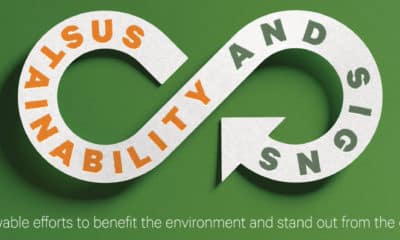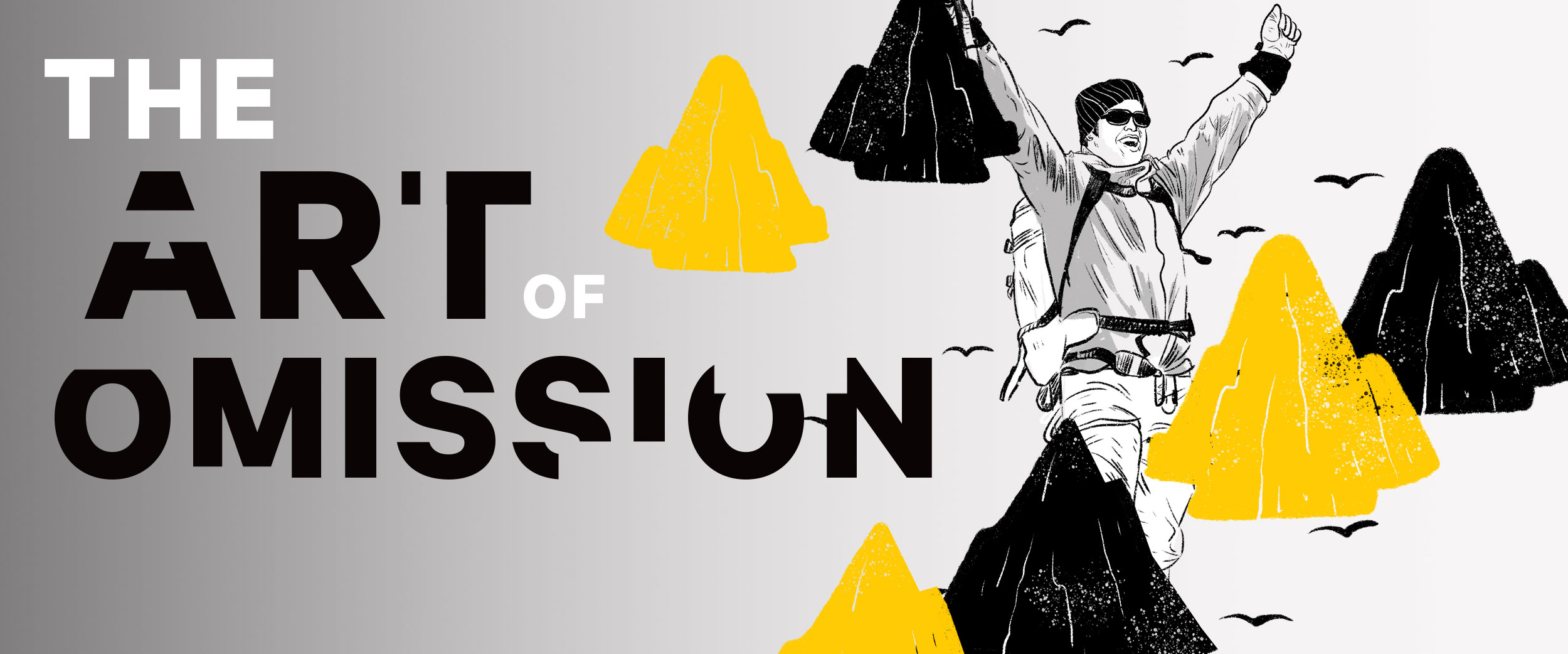
15 Tips for Running a Leaner Sign Operation
Practicing the art of omission will help curate your strategy and maximize your resources.
Published
2 years agoon
One of the defining features of the American business model is a relentless impulse to add more — more bells, more whistles, more choice, more services, more hours, more convenience, more product extensions, more … everything!
For a lot of business owners, one of the surprising lessons of the pandemic was they could get by just fine with less. Often, they had no choice but to cut down on business hours, shed staff, reduce advertising dollars and streamline operations. And they still made the same or even more money, only in a less stressful, hurried way.
Think about it and it most likely holds true in your own business experience. Throw yourself at every opportunity and you end up doing run-of-the-mill stuff, and poorly. The benefits of eliminating all but the essential things are clarity, focus and energy.
If you’re looking for a theme for 2022, perhaps “less is more” could be it. Certainly, the historical moment seems to call for it. In an essay published by Medium, writer and producer Julio Vincent Gambuto nicely sums up what’s at stake: “At no other time, ever in our lives, have we gotten the opportunity to see what would happen if the world simply stopped. [So] think deeply about what you want to put back into your life. This is our chance to define a new version of normal, a rare and truly sacred (yes, sacred) opportunity to … only bring back what works for us, what makes our lives richer, what makes our kids happier, what makes us truly proud. We get to Marie Kondo the sh*t out of it all.”
Here, we share ideas we’ve gleaned from sign professionals, industry consultants and our own reading to identify 15 areas where you could do a little less … but be so much more.

DON’T CLIMB EVERY MOUNTAIN
We’ve all heard about the Pareto Principle, the 80/20 rule that 20% of an activity produces 80% of the desired results. In a business setting, it suggests you should aim to spend 80% of your time on the 20% of activities responsible for delivering the bulk of your income. The hardest part for most is working out what not to do. “We used to offer wrap services for almost anything. If it could be wrapped we would do it, but that’s not always a good idea,” says Cathy Bacot, Wraps For Less (Orlando, FL). “There are certain things that bring in a profit and other things that waste precious time and resources and leave you flat. Over the past four years we have stopped offering wrap services for small items, motorcycles and chrome deletes to name a few. They are too time consuming for the price that you can charge and they often require repairs that lead to more loss of profit… Sometimes you just have to say, ‘we don’t offer that service,’ because it’s better to be honest up front and disappoint that one small customer than to take every job and end up wasting time and money.”
TO-DOS AND TO-DON’TS
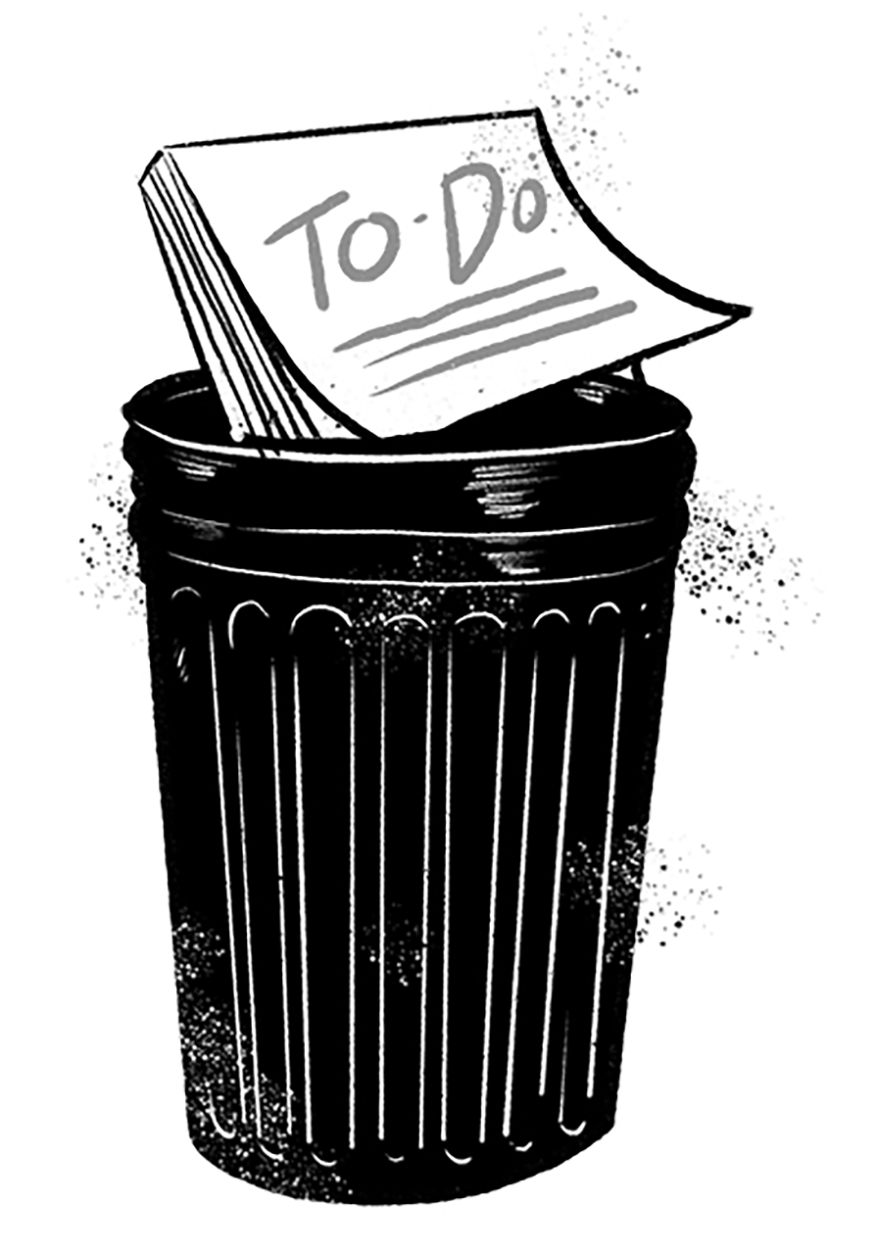
A similar logic applies to your daily to-do list. Either use a system that stores all your to-dos out of sight and out of mind (other than a handful you’re working on now) or toss it altogether. In Secrets of Productive People, Mark Forster argues for the latter. It’s still procrastination, he points out, to do a lot of pointless tasks just because it feels nice to cross them off the list, while the big, difficult thing — the one that matters — goes undone. Forster proposes a minimalist alternative: On a piece of paper, write down the five most important tasks you can think of. Then do them, in order, crossing them off as you go. (If you stop before completing one, add it again at the end.) Once the list is only two items long, add three more, to bring the total back to five. Then repeat. The point of this austere approach is that you’re regularly required to ask what really needs doing, since there are only five slots.
BE AN UNDERACHIEVER

The Underachiever’s Manifesto doesn’t sound like a book you’d find on the shelves of the ambitious business owner looking forward to doing great things in 2022. But it should be. Written by Ray Bennett, it advocates a path to achievement based on the idea that you need to leave some slack in your life to be open to the serendipity of the world and its enormously complex web of interacting variables. And to give yourself the elbow room you need to excel. “As a small shop that attempts to provide it all, I have been in a constant struggle of trying to simplify what ‘it all’ can actually reasonably entail …” says Jake Zani, Rule Signs & Graphics (Randolph, VT). “What this has meant on a practical level is that my shop now exclusively prints our semi-permanent (2-5 year) vinyl graphics on two specific premium vinyls; our house auto vinyl, and our house production vinyl. Both are premium calendered, dry-apply vinyls and both pair with only a single laminate. Everything that our shop prints gets laminated period; this means our customers get a better quality product, but more importantly in the shop we have an easier-to-install product and a single installation procedure regardless of the vinyl project being prepped for. This makes every step of the job process easier; quoting can be reduced to a handful of simple formulas that can fit on a business card, scheduling and time estimating become much more reliably predictable, as does the actual installation procedure itself (and only one procedure is needed).”
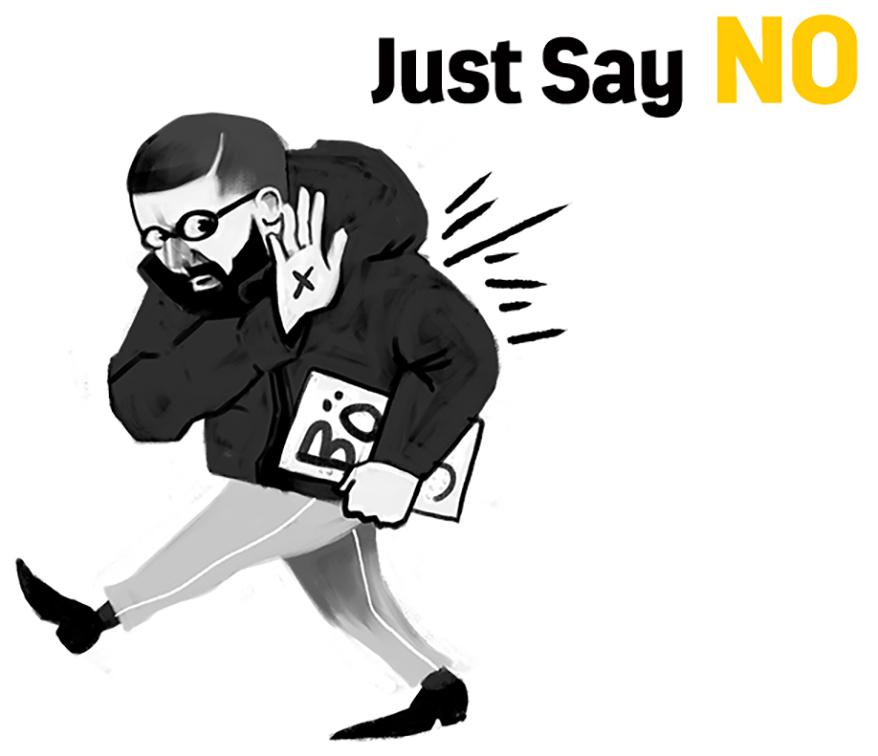
There is no middle ground here. This is one of the most important disciplines you can develop to ensure you stay focused on what’s important in your pursuit of a minimal — and sane — life. It helps to keep in mind that whenever you say “yes,” you’re also saying “no” to something else in regard to your objectives and goals. In life, every single thing involves trade-offs. Sometimes the tradeoff is from owning equipment to renting or leasing it. “We used to own a bucket truck,” says Willis Wood, RiNo Sign Works (Lakewood, CO). “After the truck continued to cost money to keep up, it was decided to sell it. Now we just rent the lifts we need for our installs and don’t have to worry about the upkeep on our own truck.” And sometimes a hard ‘no’ — with no middle ground — is the way to go. “Business cards! There is no money in business cards,” says Jennifer Boyd, Artsign Design (Boise, ID). “Can I get an Amen?”
GO PAPERLESS
A lot of sign companies love job folders or packets — the repositories for notes from every department they visit along their merry ways to job completion. But how often does someone find or remember something for the folder and have to look all over the company for it? Or worse, one goes missing? “For 18-plus years, you couldn’t convince me that our business was the type that could be paperless,” says Bob Chapa, Signarama Troy | Metro Detroit (Troy, MI). “We always rely on those printed proofs floating around the shop, right? How about the job packet with ‘all the necessary information?’ About two years ago … based on our volume spread across various departments, we finally bit the bullet overnight and went truly paperless. This required installing flatscreens in each department and organizing our workflow with substatuses through Corebridge (our sign software of choice). While that first week was tough … the truth is, we could never go back. Our sales team is now diligent in putting the correct information on work orders (since there are not any papers floating around with scribbled notes) and our production team does a great job of marking their work complete (since there are no job packets to move back up to the front office to show what they accomplished that day). I highly recommend shops of any size consider going paperless as a true way to move forward through subtraction.”
DON’T CHANGE
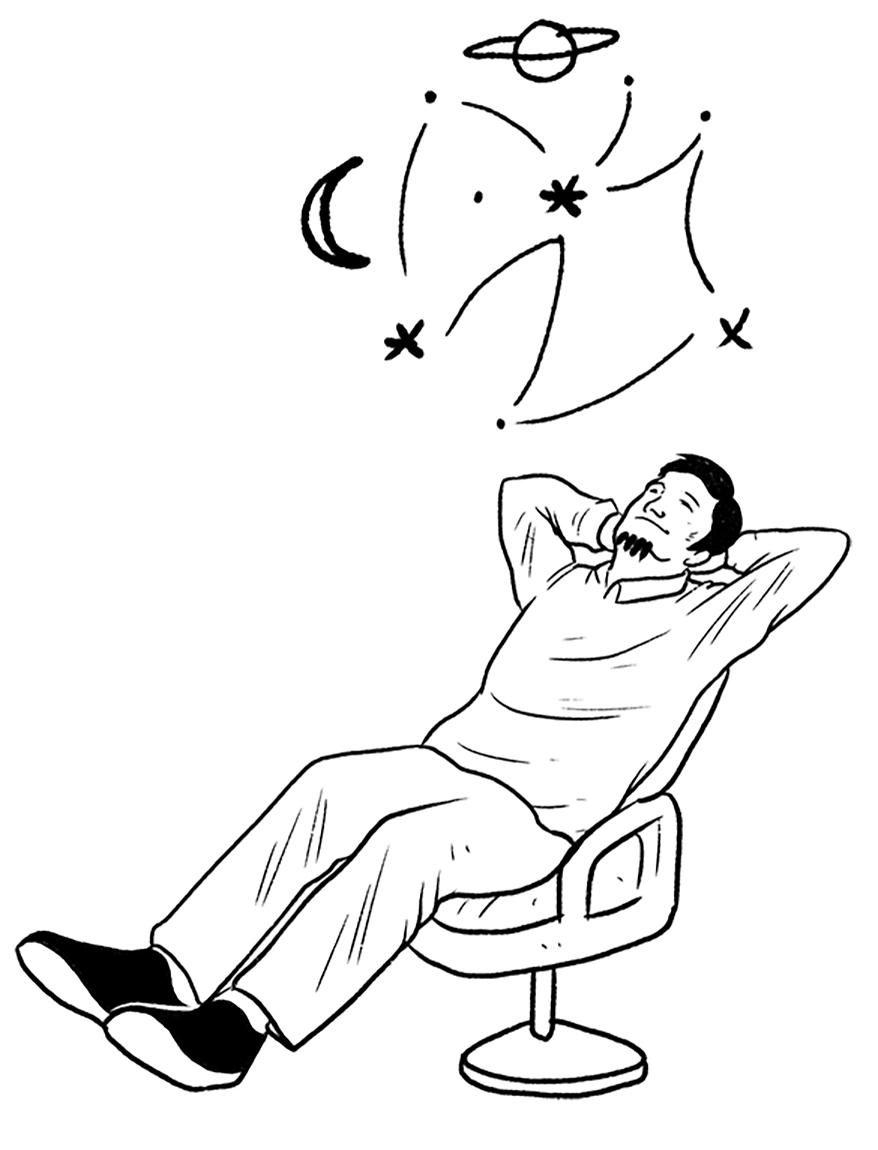
“Doing nothing isn’t an option.” Oh, yes, it is. And it’s often the best one, says Jason Fried, the co-founder of software company Basecamp in his co-authored (with David Heinemeier Hansson) anti “cult of work” manifesto It Doesn’t Have to be Crazy at Work. “‘Nothing’ should always be on the table. Change makes things worse all the time. It’s easier to f*ck up something that’s working well than it is to genuinely improve it. But we commonly delude ourselves into thinking that more time, more investment, more attention is always going to win,” he writes. “Concentrating on what you are good at, enjoy and [are] most profitable at can be the best case scenario,” says Kristie Voty, Chautauqua Sign Co. (Falconer, NY). “We have had many opportunities to grow over the past 25 years. We have opted to stay small in terms of employees. I actually enjoy working on signs, building, designing, meeting with the customer, etc. Had we branched out to more employees, different types of signs and installation (of other shops’ signs) this industry would no longer be as enjoyable. If I keep things the way they are, I have no problem continuing for many years without suffering from being burnt out.”
AUTOMATE ALL YOU CAN
One could understand if some sign companies look primarily or solely to automation in terms of production. Getting too many orders to continue bending channel letters by hand? Automate with a letter bender. But far more opportunities to automate tasks of all kinds exist in every sign company, no matter what they produce. “Much of our growth in the last 10 years is a result of addition via subtraction,” explains Cain Goettelman, FLS Banners (Sturgeon Bay, WI). “We have looked to automate repetitive steps in many places. Our order-management system allows the creation of macros. Customers can be sent automatic notifications based on their actions and order due dates. Orders can be moved to production stations automatically based on artwork approval and payment receipt. We have trained clients that place frequent orders for the same product to use customized setup templates. We learned to write scripts and create actions that automate production setup, drastically reducing prepress time. We created our own QR code inventory tracking system that works with Google Sheets. It allows a roll of substrate or a bottle of ink or another inventory item to be scanned and have the usage posted to a Google sheet. The sheet then tracks real-time inventory usage. The one thing these all have in common is reducing data entry and the need for repetitive tasks.”
OVERFUNCTION INJUNCTION
Many business owners and managers fall into the category known as “overfunctioners.” Faced with a challenge — an employee who is not doing a task properly or a request for help — they immediately jump in and do it themselves. It’s an approach that is not only tiring but reinforces the expectant or helpless behavior of customers and staff. Don’t assume that because someone else wants something done, it needs doing, says the law professor Elizabeth F. Emens in her book The Art of Life Admin. Learn to use strategic delay (some things sort themselves out), and train employees to recognize when a version of “Google it yourself!” is the answer to their question. Such an approach means potentially letting small bad things happen and tolerating the resulting anxiety. To quote the psychologist Carin Rubenstein, overfunctioners need a new motto: “Be less than you can be!”
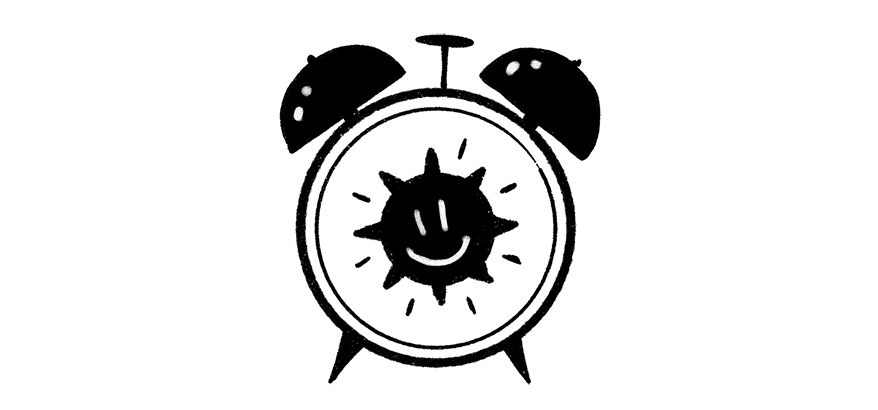
QUITTIN’ TIME
Working fewer days and hours is obviously great for families, friendships, hobbies and the human spirit. But the most interesting implication of recent research is that it appears to be good for productivity and work quality, too. The brain needs rest to operate well. Meanwhile, fixed shorter hours provide a useful sense of constraint: knowing you’ve got to squeeze everything into fewer hours seems to improve efficiency overall. In 2016’s Deep Work, Cal Newport advocates this approach via “fixed-schedule productivity” — that is, setting certain periods for intense important work during a day, applying a short transition period or ritual to mark the end of the workday and then completely stopping at, say, 5 p.m.

THE CAREER EDIT
According to Matthew May, author of The Laws of Subtraction: 6 Simple Rules for Winning in the Age of Excess Everything, at the heart of every challenge or business decision lie three tough choices: What to pursue versus what to ignore; what to leave in versus what to leave out; and what to do versus what not to do. “I have discovered that if you focus on the second half of each choice — what to ignore, what to leave out, what not to do — the decision becomes exponentially simpler. The key is to remove the extraneous stuff — anything obviously excessive, confusing, wasteful, hard to use or ugly,” he writes. “This is the art of subtraction: when you remove just the right thing in just the right way, something great is bound to happen.” Cathy Bacot from Wraps For Less agrees: “We do not offer wrap services [any longer] for things we know will start to peel or fail in a short amount of time … We are busy enough now to have the luxury to pick and choose what we want to do and we don’t feel the need to bring in every job that crosses our entrance anymore.”
IRREPLACEABLE?
The best employees may not be replaceable, but they don’t necessarily need to be either. Outsourcing can save money on benefits and training, as well as provide access to a larger talent pool for specialized skill sets. “A key employee decided to leave our business,” says John Miller, Signs by Autografix (Branford, CT). “I was concerned about this loss and found it extremely difficult to hire the right replacement. In the interim we outsourced his work. It soon became clear that doing that was a fine solution, which lowered our payroll and related expenses and eliminated the problem.”
AdvertisementPURGE LOW-VALUE CUSTOMERS
Be willing to fire customers who are a drain on your resources, says Anthony K. Tjan. Writing in the Harvard Business Review he recommends regularly subtracting the least valuable 5% of your customer base. “It is a fallacy that you need to keep all your customers because many of the small customers will become large ones,” he says, recommending you look at your data to see if that has really occurred. What you are more likely to find, he argues, is a stubbornly consistent 5% of your customers who buy in small volumes and require higher maintenance as a cohort than other groups. “Sometimes you have to take a look at your customers and what they are costing you,” says Mallory Lynn from Signarama Brighton in lovely Brighton, CO. “We had a customer that would order very small vinyl items pretty frequently for suite signs. Since they were a very large company they had special requests on how everything was billed and how they wanted the invoices labeled. Needless to say, it became a very convoluted process. After working with them for years we decided it was best for the business to break up. Even though we were terrified of losing the account, it freed us up to bring in new business that helped us reach our growth goals that following year. Sometimes cutting the dead weight can be terrifying, but what opportunities are out there waiting for you?”
SUCCINCT SELLING
Use half as many words and they’ll hit twice as hard. Every writer knows it. Salespeople need to learn it. When you talk too much you come across as anxious and nervous or defensive and combative. “Selling is a transfer of confidence. The seller must transfer his or her confidence in the product to the buyer. When you babble, you don’t sound confident,” says Roy H. Williams, author of the bestselling Wizard of Ads. “Always answer questions as asked. This means that you should focus your energies on providing the simplest answer in the fewest words. If your customer wants to know more, they’ll ask you a follow-up question.”
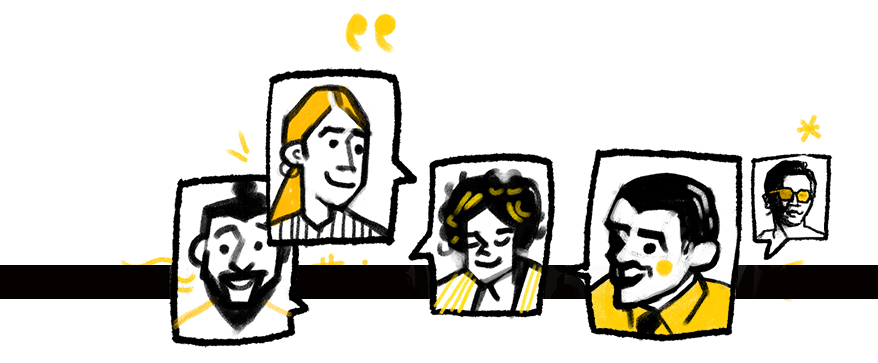
MEET LESS OFTEN
Meetings have a bad rap as a time trap — often justified. According to studies, executives find at least half of meetings unproductive. But if you’re a business owner or manager, you’re probably already thinking of reasons why you couldn’t do without them. Perhaps then you can strive for fewer and better. Here’s the key question for distinguishing a worthwhile meeting from a worthless one: Is it a “status-report” meeting, designed for employees to tell each other things? If so, it’s probably better handled via email or the bulletin board in the backroom. That leaves a minority of “good” meetings, whose value lies in the coming together of minds, for example, such as a well-run brainstorming session.
A FEW FINAL WORDS
Simplifying your life, subtracting the extraneous or finding the elegant solution to a problem can be difficult and at times dispiriting because they imply that no, you can’t have it all, you can’t do everything you want in life or business. But this shouldn’t be dispiriting. In fact, it’s liberating, says Oliver Burkeman, author of Four Thousand Weeks: Time Management for Mortals. Knowing you can’t possibly get everything done spares you the anxiety of trying to figure out how you could. To spend time or effort on anything is, by definition, to choose not to spend that time or effort on an infinite number of alternatives. Declining to do something that seems worthwhile — say, learning how to trade stocks — is a reaffirmation that doing the best job for your current customer matters more.
Signs of the Times has been the world leader in sign information since 1906. Contact Signs of the Times' editors at editor@signsofthetimes.com.

SPONSORED VIDEO
Introducing the Sign Industry Podcast
The Sign Industry Podcast is a platform for every sign person out there — from the old-timers who bent neon and hand-lettered boats to those venturing into new technologies — we want to get their stories out for everyone to hear. Come join us and listen to stories, learn tricks or techniques, and get insights of what’s to come. We are the world’s second oldest profession. The folks who started the world’s oldest profession needed a sign.
You may like

Avery Dennison Adopts Mimaki Printer for Traffic Sign Print System

Fiery Releases SignLab 11

21 Larry Albright Plasma Globes, Crackle Tubes and More
Subscribe

Bulletins
Get the most important news and business ideas from Signs of the Times magazine's news bulletin.
Most Popular
-

 Tip Sheet3 days ago
Tip Sheet3 days agoAlways Brand Yourself and Wear Fewer Hats — Two of April’s Sign Tips
-

 Business Management1 week ago
Business Management1 week agoWhen Should Sign Companies Hire Salespeople or Fire Customers?
-

 Women in Signs2 weeks ago
Women in Signs2 weeks ago2024 Women in Signs Award Winners Excel in Diverse Roles
-

 Real Deal4 days ago
Real Deal4 days agoA Woman Sign Company Owner Confronts a Sexist Wholesaler
-

 Editor's Note1 week ago
Editor's Note1 week agoWhy We Still Need the Women in Signs Award
-

 Maggie Harlow2 weeks ago
Maggie Harlow2 weeks agoThe Surprising Value Complaints Bring to Your Sign Company
-

 Line Time2 weeks ago
Line Time2 weeks agoOne Less Thing to Do for Sign Customers
-

 Product Buying + Technology1 week ago
Product Buying + Technology1 week agoADA Signs and More Uses for Engraving Machines




